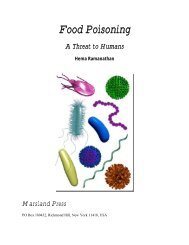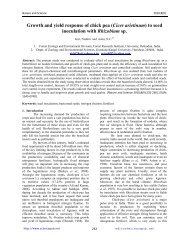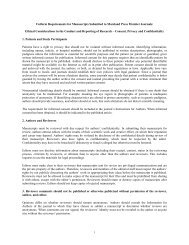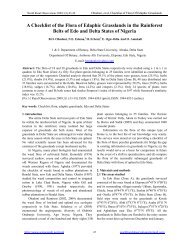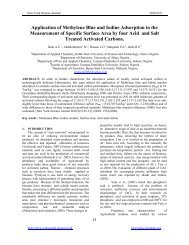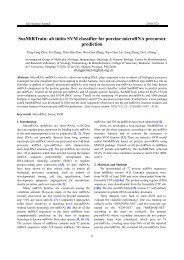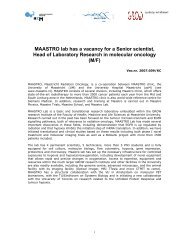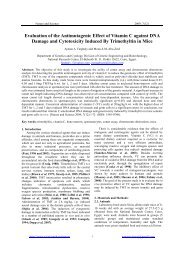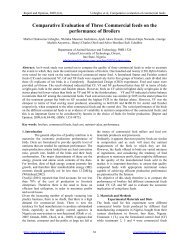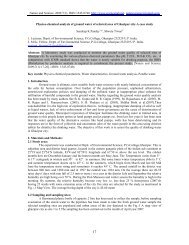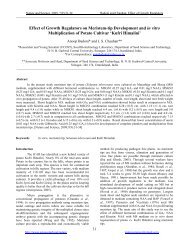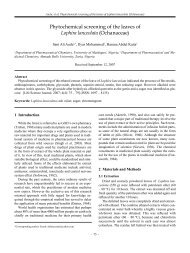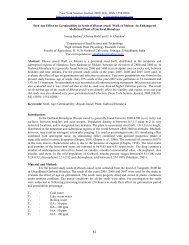Ecological, Social and Commercial Role of Lichens in India with ...
Ecological, Social and Commercial Role of Lichens in India with ...
Ecological, Social and Commercial Role of Lichens in India with ...
Create successful ePaper yourself
Turn your PDF publications into a flip-book with our unique Google optimized e-Paper software.
Acdemia Arena 2010, Supplement 0201<br />
http://www.sciencepub.net<br />
sheep <strong>and</strong> goats belong<strong>in</strong>g to several families from one or more villages. Grazers com<strong>in</strong>g from<br />
beyond adjacent areas <strong>of</strong>ten pick up sheep <strong>and</strong> goats from the villages they pass through on their<br />
way to the KWLS. Such grazers <strong>of</strong>ten stay <strong>in</strong> local farmers fields. Their flock can manure the fields<br />
while the grazers are given food <strong>and</strong> shelter <strong>in</strong> exchange. The grazers also are paid by the villagers,<br />
<strong>of</strong>ten <strong>in</strong> k<strong>in</strong>ds rather than cash, for tak<strong>in</strong>g their sheep <strong>and</strong> goats <strong>in</strong>to the KWLS.<br />
The impact <strong>of</strong> graz<strong>in</strong>g on the KWLS areas is not fully known. However livestock’s are known<br />
to transmit diseases to wild animals, encourage weeds growth, <strong>and</strong> prevent regeneration <strong>of</strong> trees <strong>in</strong><br />
low-altitude patches. Studies <strong>of</strong> the impact <strong>of</strong> graz<strong>in</strong>g on forests have shown that the graz<strong>in</strong>g <strong>of</strong><br />
livestock not only h<strong>in</strong>ders regeneration <strong>of</strong> naturally dom<strong>in</strong>ant tree species, but it can also lead to<br />
significant changes <strong>in</strong> the structure <strong>and</strong> composition <strong>of</strong> different plant species on the forest floor.<br />
Lichen exploitation<br />
The lichens are collected exhaustively throughout Himalaya <strong>and</strong> are frequently used as<br />
<strong>in</strong>gredient <strong>of</strong> spices, Aurvedic medic<strong>in</strong>es <strong>and</strong> other purposes. Every year about 10,000 tons <strong>of</strong><br />
lichen is collected from the Central Himalayan region <strong>of</strong> <strong>India</strong>. But <strong>in</strong> the protected areas like<br />
KWLS, lichen exploitation is totally b<strong>and</strong>. <strong>Commercial</strong>ly the lichens are sold <strong>in</strong> the name <strong>of</strong><br />
“Charrila” or “Jhoola”.<br />
References<br />
Champion, H.G. <strong>and</strong> Seth, S.K. (1968). A Revised Survey <strong>of</strong> the Forest Type <strong>of</strong> <strong>India</strong>.<br />
Govvernment <strong>of</strong> <strong>India</strong> Publication <strong>India</strong>, Delhi. Sundriyal, R.C. (1992). Structure<br />
productivity <strong>and</strong> energy flow <strong>in</strong> alp<strong>in</strong>e grassl<strong>and</strong> <strong>in</strong> the Garhwal Himalaya J. Veg. Sci. 3:<br />
15-20.<br />
12




